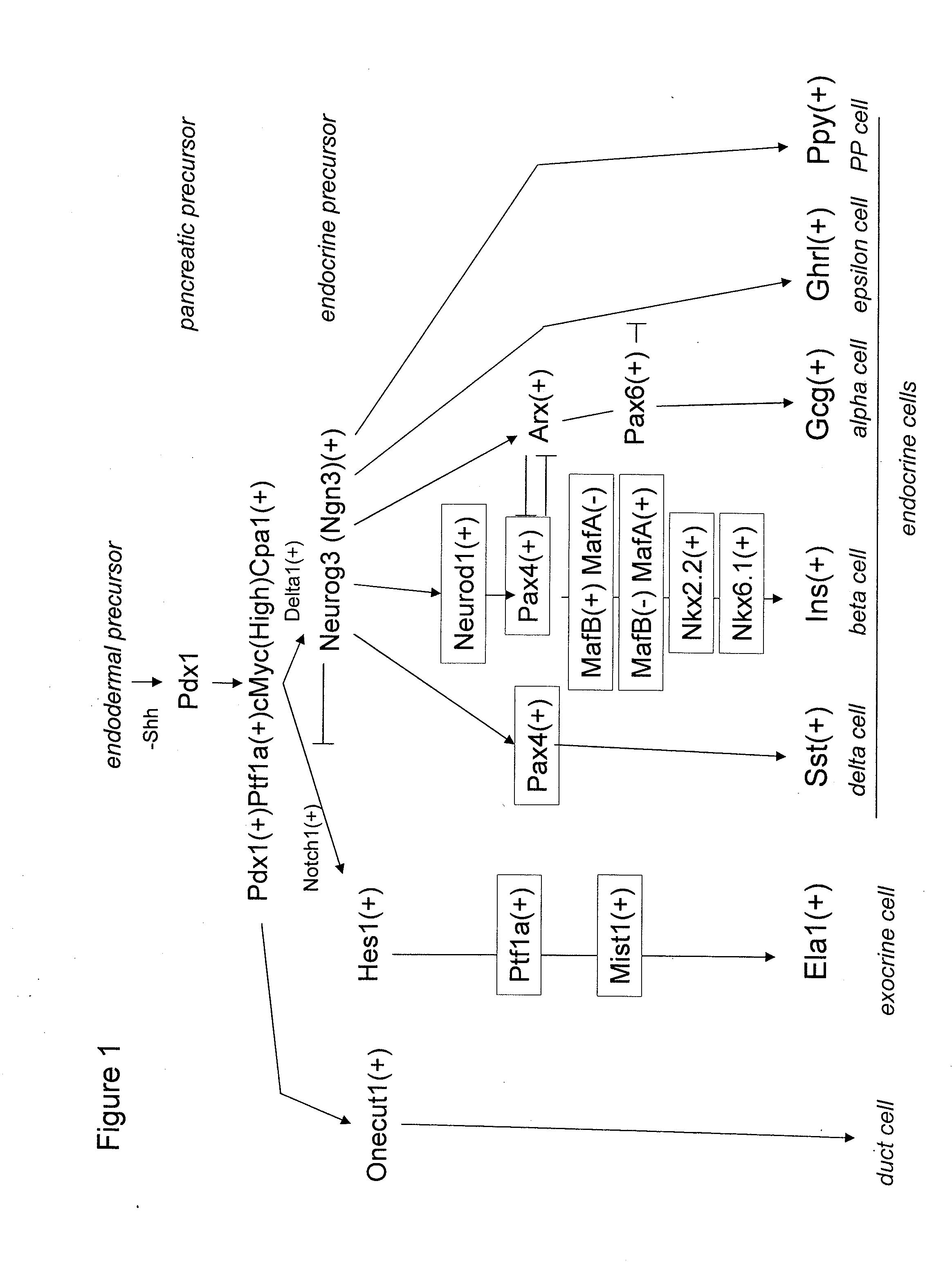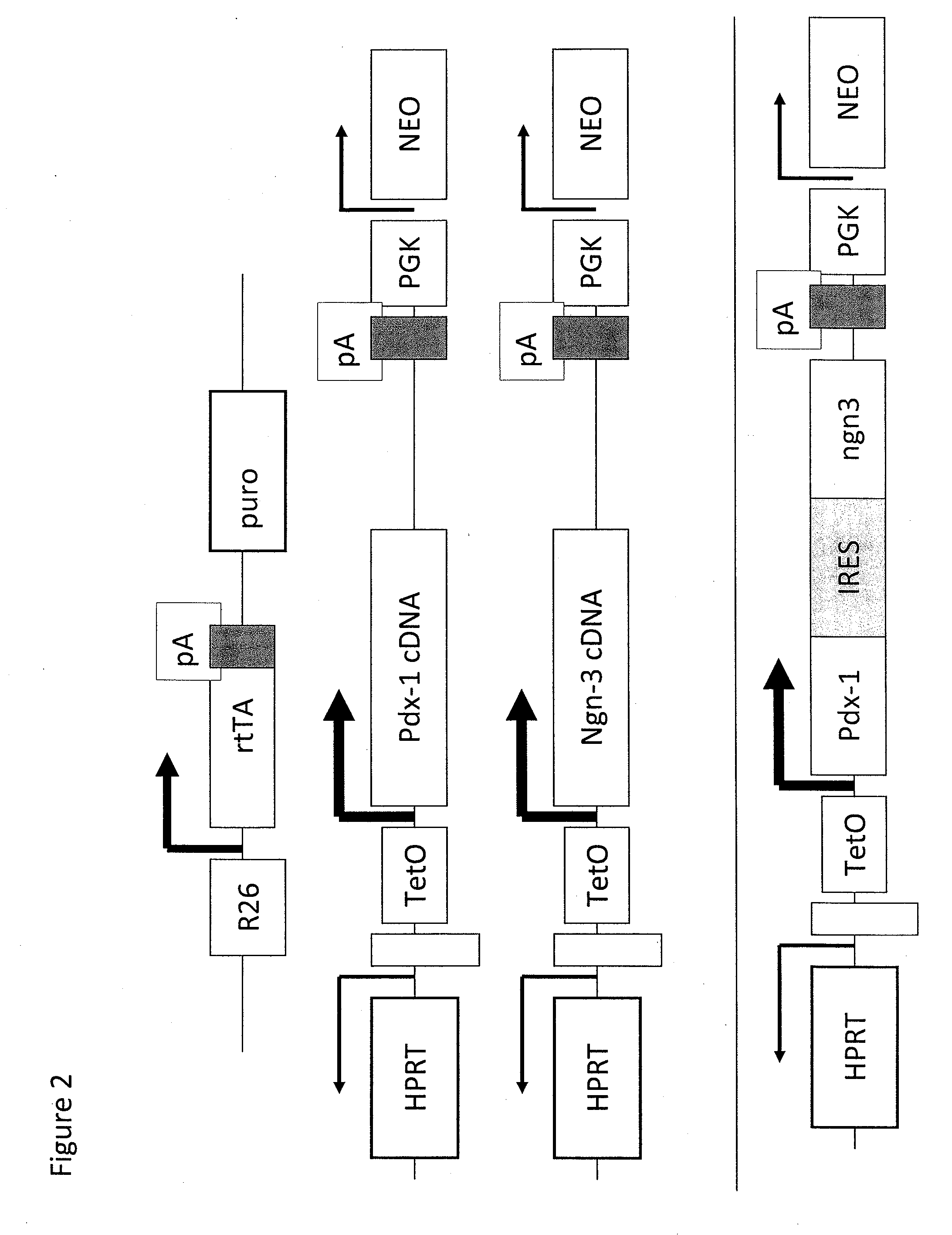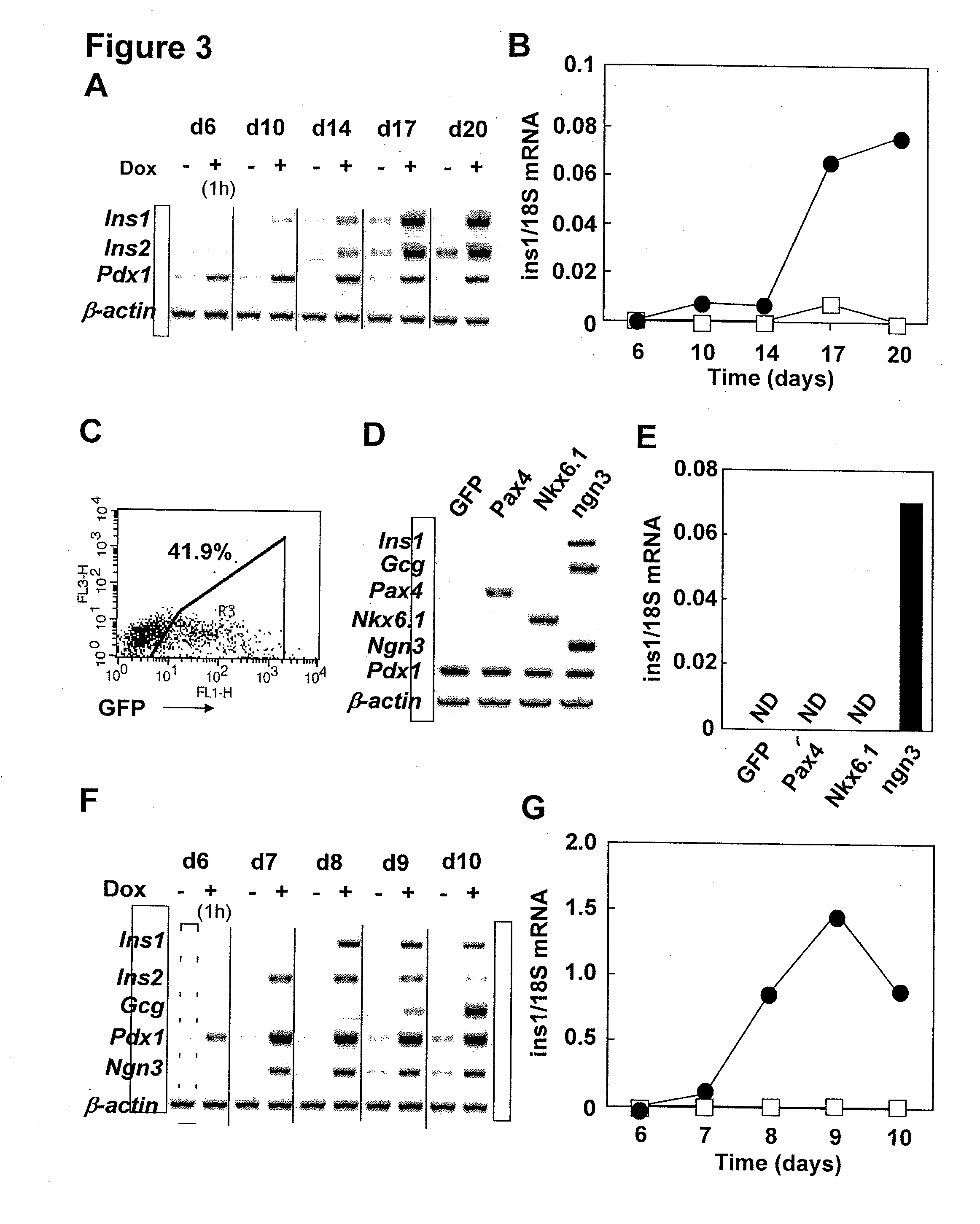Pancreatic endocrine progenitor cells derived from pluripotent stem cells
a technology of pluripotent stem cells and which is applied in the field of pancreatic endocrine progenitor cells derived from pluripotent stem cells, can solve the problems of limited applicability, and achieve the effect of sufficient tim
- Summary
- Abstract
- Description
- Claims
- Application Information
AI Technical Summary
Benefits of technology
Problems solved by technology
Method used
Image
Examples
example 1
Pdx1 and Ngn3 Induce Insulin mRNA Expression in Activin-Induced Endoderm EBs
Material and Methods
Growth and Differentiation of ES Cells
[0144]To assess the gene function in developmental progression of pancreas during ES cell differentiation, Ainv 18 ES cells were used. The cells can be used to target gene expression, which can be induced by exposure to doxycycline (Dox) (Sigma, St. Louis) at specific time points (Kyba, M. et al. 2002 Cell 109:29-37). Pdx1 or pdx1-IRES-ngn3 plox vectors (FIG. 2) were electroporated into Ainv 18 ES cells to yield Tet-pdx1 or Tet-pdx1 / ngn3 ES cells. These cells can be induced to express Pdx1 or both Pdx1 and Ngn3 by Dox, respectively. ES cells were maintained on irradiated mouse embryo fibroblast feeder cells as previously described (Kubo, A. et al. 2004 Development 131:1651-1662). To generate embryoid bodies (EBs), ES cells were dissociated into a single cell suspension using trypsin and then cultured at various concentrations in 60 mm petri-grade dish...
example 2
BMP4 Improved Gene Expressions of Ins1 Induced by Pdx1 and Ngn3 in Serum-Free Differentiated Media
Materials and Methods
[0154]Differentiation in serum-free differentiation medium (SFD) was carried using SFD condition described by Gouon-Evans, V. et al. 2006 Nat. Biotechnol. 24(11):1402-1411. SFD consisted of 75% IMDM and 25% Ham's F12 medium (Gibco) supplemented with 0.5% N2 and 1% B27 (with RA) supplements (Gibco), 1% penicillin / streptomycin, 0.05% bovine serum albumin, 2 mM glutamine, 0.5 mM ascorbic acid and 4.5×10−4 M MTG. ES cells (2−4×104 cells / ml) were cultured in SFD in 60 mm Petri-grade dishes. At day 2 of differentiation, EBs were dissociated with trypsin / EDTA and replated at density of 2−6×104 cells / ml in SFD supplemented with activin A (50 ng / ml) in 60 mm petri-grade dishes. The day 4 EBs were dissociated with trypsin / EDTA and were reaggregated by culture at high density (5×105 cells / ml) in 24-well low-cluster dishes (Coaster) in SFD supplemented with BMP-4 (50 ng / ml) (R&...
example 3
Pancreas Related-Genes are Induced by Pdx1 and Ngn3 in SFD Condition
[0157]RT-PCR analysis demonstrated that overexpression of Pdx1 and Ngn3 in EBs induced a number of pancreas related-genes in addition to insulin (FIG. 5). Induced genes were categorized as follows; Secretory proteins (FIG. 5A): 1) pancreatic endocrine genes; Ins1, Ins2, Gcg, Sst, Ppy, and Ghrl. 2) Incretine hormone related-genes; Gip and Glp1r. 3) Exocrine genes; Amy and Ela. Liver and intestine related-genes such as Alb, Afp and Fabp2 are suppressed by Dox induction. Shh, which is important to be suppressed in pancreatic endoderm, was also suppressed by Dox induction. Insulin secretion related-genes (FIG. 5B): 1) insulin processing related-genes: Pcsk1, Pcsk2 and Chga. 2) glucose sensing related-genes: Glut2 and Gck. 3) potassium channel related-genes: Kir6.2. Pancreas related-transcriptional factors (FIG. 5C): Ptfa1, Pax4, Pax6, neuroD, Isl1, Nkx×2.2, MafA, and Hex. These results suggest that many important genes ...
PUM
| Property | Measurement | Unit |
|---|---|---|
| concentration | aaaaa | aaaaa |
| concentration | aaaaa | aaaaa |
| density | aaaaa | aaaaa |
Abstract
Description
Claims
Application Information
 Login to View More
Login to View More - R&D
- Intellectual Property
- Life Sciences
- Materials
- Tech Scout
- Unparalleled Data Quality
- Higher Quality Content
- 60% Fewer Hallucinations
Browse by: Latest US Patents, China's latest patents, Technical Efficacy Thesaurus, Application Domain, Technology Topic, Popular Technical Reports.
© 2025 PatSnap. All rights reserved.Legal|Privacy policy|Modern Slavery Act Transparency Statement|Sitemap|About US| Contact US: help@patsnap.com



